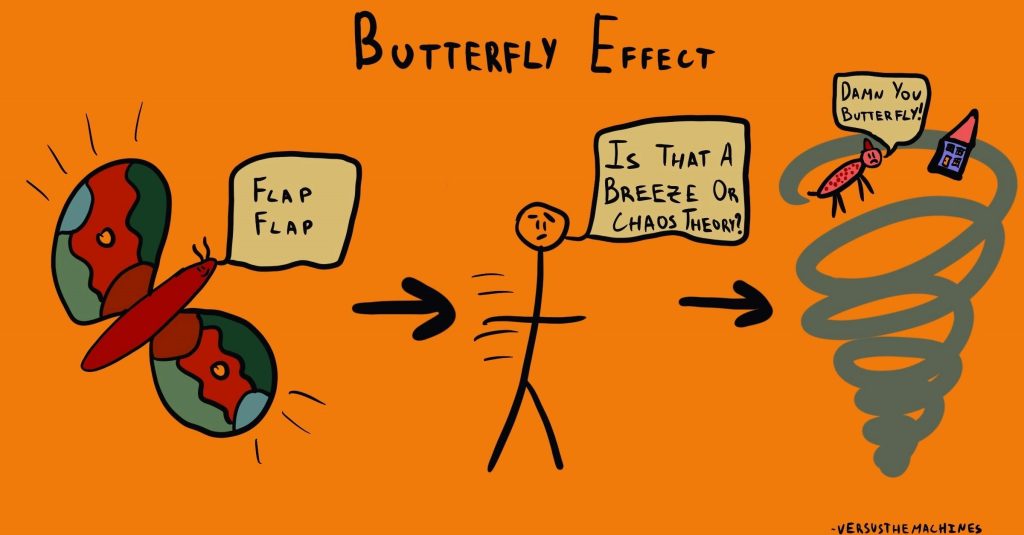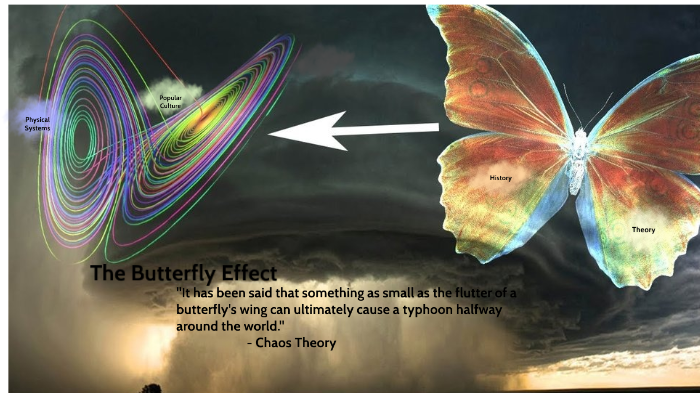The world is vast and complex and it may sometimes seem that our small decisions and actions have little to no impact on the big picture. However, if you think about minute details of your life, you may be able to see how a small event was actually the catalyst for a huge change in your life. For example, maybe you bumped into someone at a coffee shop that happens to work at your dream company and eventually got you an interview there. What if you had chosen a different coffee shop, or been there five minutes later? You may not have met the person that got you into your dream job. The idea that something small, like getting coffee, can have much larger effects, such as altering your career is called the butterfly effect.

What is the Butterfly Effect?
The butterfly effect is the idea that small, seemingly trivial events may ultimately result in something with much larger consequences – in other words, they have non-linear impacts on very complex systems. For instance, when a butterfly flaps its wings in India, that tiny change in air pressure could eventually cause a tornado in Iowa.
The effect is named after an allegory for chaos theory; it evokes the idea that a small butterfly flapping its wings could, hypothetically, cause a typhoon. Or it could not – the mind-boggling part of the butterfly effect is that it’s virtually impossible to predict whether a small system will lead to chaotic behavior.

Chaos Theory
The butterfly effect is part of chaos theory, which states that there are limitations to predictions even in small discrete systems. Chaos is possible because systems are extremely sensitive to initial conditions. Small differences in starting conditions can, over time, make a big difference in the way that a complex system of interrelated phenomena evolves.Systems usually have feedback loops, which also means that once those small differences are incorporated within its system, there is no telling what will later be affected – it is out of our control. Chaos theory is specifically interested in the study of random or unpredictable behavior even in systems that are supposed to be governed by deterministic laws. Deterministic laws are supposed to remove any randomness, as determinism in a philosophical sense is the idea that all events are completely determined by previous existing causes. The butterfly effect dispels the idea of deterministic systems, as it suggests that there are non-linear ways in which small differences change the effects of a cause.

Black Swan
The butterfly effect is related to another phenomenon, the black swan. Black swans are events that are ‘outliers’, seemingly random but with life-changing impact on our world. The key understanding of black swans, similar to the butterfly effect, is that it is impossible to predict these events, even though they are ultimately consequential.

History
The term “butterfly effect” was coined in the 1960s by Edward Lorenz, a meteorology professor at the Massachusetts Institute of Technology, who was studying weather patterns. He devised a model demonstrating that if you compare two starting points indicating current weather that are near each other, they’ll soon drift apart – and later, one area could wind up with severe storms, while the other is calm.
At the time, weather statisticians thought you should be able to predict future weather based on looking at historical records to see what had happened when conditions were the same as they are now. Lorenz was skeptical. He was running a computer program to test various weather simulations and he discovered that rounding off one variable from .506127 to .506 dramatically changed the two months of weather predictions in his simulation.
His point was that long-range weather forecasting was virtually impossible, in large part because humans don’t have the ability to measure nature’s incredible complexity. There are simply too many minute variables that can act as pivot points, cascading into much bigger consequences.
So, while people often think the butterfly effect means that tiny changes can have big consequences (and we can track this progression to see what change caused what), Lorenz was trying to say that we can’t track these changes. We don’t really know exactly what would cause a weather pattern to go one way over another.
Lorenz called this “sensitive dependence on initial conditions” when he introduced his work to the public in a 1963 paper titled, “Deterministic Nonperiodic Flow.” (The term “butterfly effect” he coined in later speeches about the topic.) The paper was rarely cited by other researchers – at least, at first.

Examples of the Butterfly Effect
The Butterfly Effect can be observed in various natural and human-made systems, such as:
a) Weather and Climate: The Earth’s atmosphere is a highly complex and interconnected system, where even minuscule changes can trigger cascading effects, ultimately influencing weather patterns and climate.
b) Ecology: Small alterations in an ecosystem, like the introduction or removal of a species, can set off a chain reaction that affects the entire ecosystem’s balance.
c) Economy: The global economy is a complex network of interacting elements, where a small change in one area can propagate and cause significant consequences in other areas.
d) Human Behavior: Individual decisions and actions can have broader implications, influencing the lives of others and even shaping societal norms and values.

Implications and Applications
The Butterfly Effect underscores the importance of considering the potential consequences of small actions or decisions. It serves as a reminder that caution is necessary when intervening in complex systems, as unintended outcomes can easily arise.
In fields such as meteorology, understanding the Butterfly Effect has led to improved forecasting techniques by acknowledging the limitations of long-term predictions. Similarly, in fields like ecology and economics, awareness of the Butterfly Effect has helped inform more effective management strategies that account for the inherent unpredictability of complex systems.
The Butterfly Effect is a powerful concept that demonstrates the interconnected nature of complex systems and the potential for small changes to yield significant consequences. By recognizing this phenomenon, we can better appreciate the importance of careful decision-making and the need to account for the inherent uncertainty in our actions.

The butterfly effect in action
Even if you don’t care about predicting the weather, the butterfly effect is everywhere. Being aware of its powerful impact on outcomes can be crucial to humble predictions and realistic decision-making. Here are three examples of the butterfly effect in psychology, history, and business.
- Dynamic systems in cognitive science. Bifurcation and non-linearity are central to the way the mind works. Tiny changes in neurotransmitters can have a massive impact on cognition. It’s often impossible to know what exactly tipped a cognitive system. “The dynamic approach to cognition emphasises the complex process of human development including mental, behavioural, neural and social systems interacting with each other over the life course (…) Small changes in certain parameters can lead to enormous effect on their attitudes, actions, and behaviours which are before seen as coherent, stable, consistent, and predictable,” explain researchers of Yüzüncü Yıl University’s Department of Psychiatry.
- The catalyst for World War II. There have been many books and movies speculating about how history would have been different if a young Adolf Hitler had been accepted in art school. He was rejected twice by the Academy of Fine Arts in Vienna, once in 1907 and again in 1908. Imagine a world where Hitler had been solely focused on painting quaint countryside landscapes with trees and lake houses. A seemingly small decision from a school committee resulted in events that shaped the world.
- Chaos in business. “We all seem to be looking for the Holy Grail, the nexus point in a complex system. This is where a small change in the marketing mix will yield a large improvement in marketing dynamics,” writes Rajagopal in The Butterfly Effect in Competitive Markets. Many business models wrongly apply linear thinking to complex problems. A typical example is the rational customer who always maximises economic utility. We now know it’s not the case. Consumer decisions may seem predictable at first, but they are chaotic and complex: consumers don’t actually behave like rational agents. Again, it may be hard to predict exactly which factor may tip their behaviour one-way or another; and even harder to predict their behaviour over long periods of time.
While we can be mindful of our starting conditions and try to generate the best catalysts to achieve our goals, understanding the butterfly effect is about embracing the chaotic nature of life. Our current data can only bring us so far in predicting the future; small changes can have a massive impact on the outcome. In order to succeed, we need to constantly adjust our forecast. Only then we can thrive in the midst of complexity.














Leave a comment